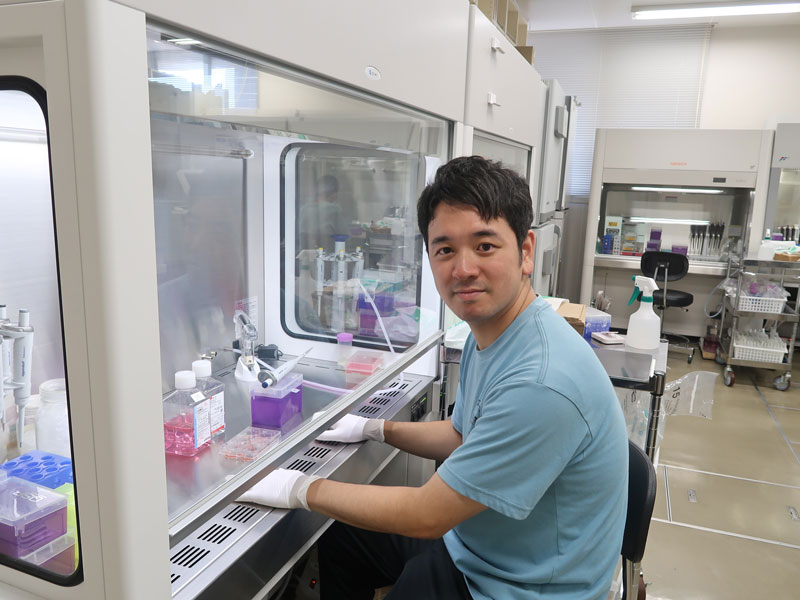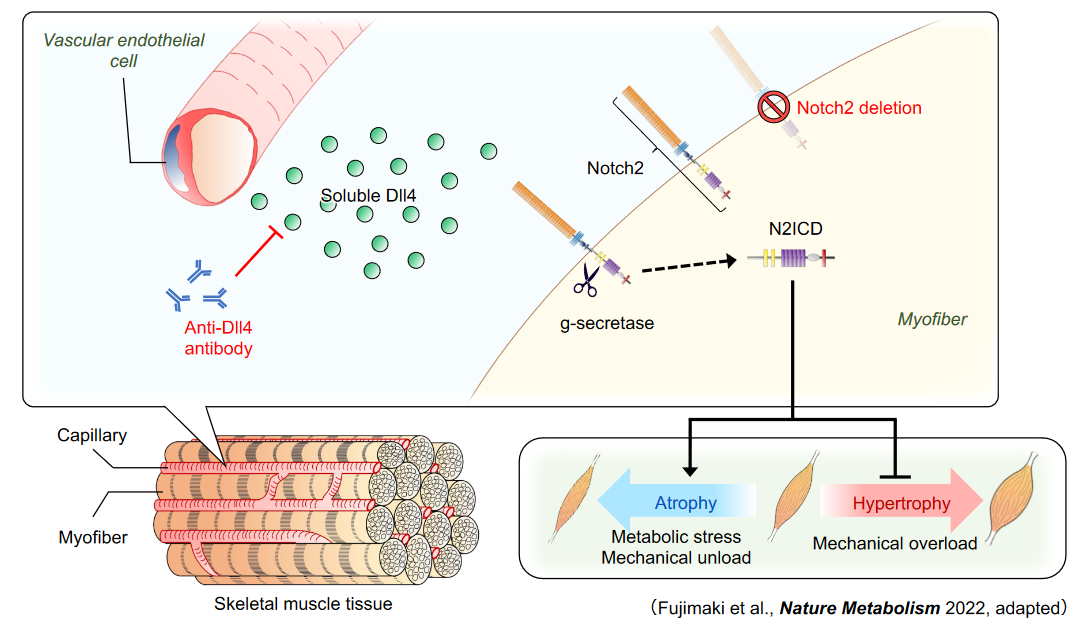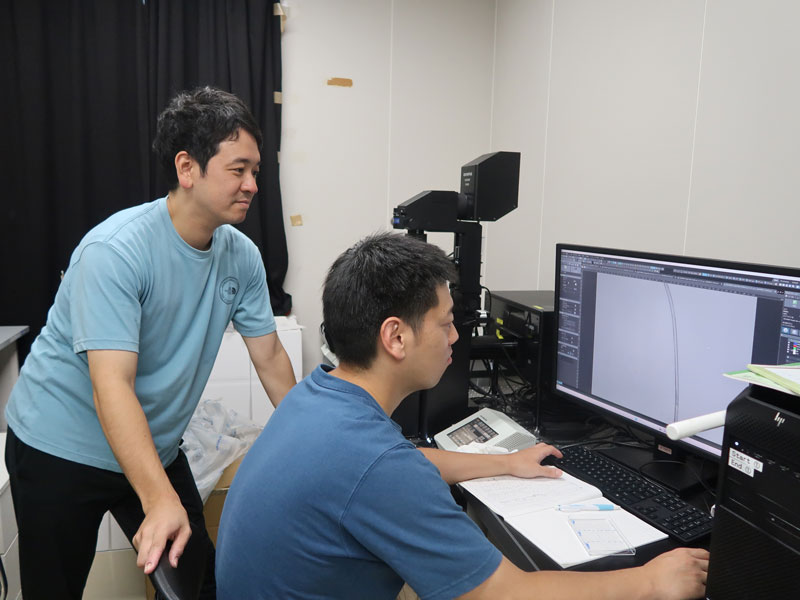Why do muscles grow and shrink? Uncovering the mechanisms will unlock the way for drug development.


Dr. Shin Fujimaki, Assistant Professor,
Institute of Molecular Embryology and Genetics, Kumamoto University
At the Institute of Molecular Embryology and Genetics at Kumamoto University, there are various research fields, and we spoke to Assistant Professor Shin Fujimaki, who is conducting research on skeletal muscle in the field of muscle development and regeneration. We all know that muscles grow if you work them out and shrink if you don’t, but why is that? He is working hard every day to uncover the mechanism behind this.
The blood vessels that run through the muscles send signals to the muscles!
First of all, please tell us about the content of your research.I belong to a laboratory in the department of muscle development and regeneration led by Prof. Yusuke Ono. In this laboratory, we are researching the mechanisms of skeletal muscle development and regeneration, as well as muscle hypertrophy and atrophy. By identifying these mechanisms, we aim to develop treatments and preventative measures for sarcopenia – a condition that causes muscle atrophy due to aging. One of my goals is to clarify the detailed mechanisms, including side effects, in order to pave the way for drug discovery.
Among these, I am conducting research focusing on the plasticity of muscles. Plasticity is a term that refers to the property of being able to respond flexibly to external stimuli and change. It is well known that muscle can be trained to grow larger, and that muscle atrophy can occur when a person wears a cast for a broken bone or injury. I want to clarify the mechanism behind why muscle hypertrophy and atrophy occur in muscles that have already developed, in other words, in the muscles of adults.
What has been discovered so far?
Research into the mechanisms that control muscle size is being carried out all over the world, and we are finding out a lot. However, there are still many questions about how this happens. It is known that muscles atrophy not only when they are inactive, such as when immobilized in a cast or bedridden for a long period of time, but also when they are affected by chronic diseases such as diabetes, cancer, and kidney disease, as well as infectious diseases such as COVID-19.
Muscle is a tissue made up of groups of fiber-like cells called muscle fibers. Most previous research on muscle plasticity has focused on what genes are active within muscle fibers, and there has been little research on the upstream mechanisms. So, I focused on the area around the muscle fibers, or outside the muscle fibers, and began research to identify what induces muscle atrophy.
What I discovered was that signals that cause muscle atrophy are sent from the blood vessels that run between muscle fibers. The main role of blood vessels it to transport oxygen and nutrients throughout the body, but recently it has been discovered that the endothelial cells that make up blood vessels secrete factors that act on various tissues, not just muscles. These factors are collectively called angiocrine factors, and we have discovered that some of them act on muscles. This was reported in our paper in 2022.

Regulation of muscle plasticity by the vascular DII4-musclar Notch2 axis
Do diseases cause the factor to atrophy the muscles?
In the paper, we used a model of diabetes. When a person has diabetes, a protein called DII4, which we are focusing on, is released in large quantities from the blood vessels and acts on the muscle fibers. We have also confirmed that muscle atrophy is induced by the same mechanisms even in cases where the muscles are immobilized by wearing a cast. However, we still haven’t figured out whether it is blood vessels that are giving the command to shrink or whether it is the muscles that are asking to be smaller, so we are continuing our research.
In fact, it has been found that DII4 also works to make muscles smaller when they are subjected to exercise stimuli that cause them to grow. The reason for this is that we do not want our muscles to overgrow i.e. put a brake on muscle growth.
You might think that the bigger the muscles, the better, but the bigger the muscles, the more energy they require. For example, in the hunting era, even when there was no prey to be caught, it would be a problem if humans had big muscles and required a lot of energy. That’s why I think there is a system to put the brakes on muscles from growing too big.
Experiments on mice have shown that blocking the signal that applies the brakes on muscle growth makes muscle hypertrophy more efficient, so if the mechanisms of muscle hypertrophy and atrophy can be clarified in detail, I think it will lead to the development of drugs that can help people with diseases and the elderly maintain muscle mass even with less strenuous muscle training.

Together with Professor Ono(center) in Colorado
“If you are going to do it, do it big!” Professor Ono’s words in my heart.
Why did you start this research?I studied exercise physiology at the School of Physical Education, Health and Sport Sciences, University of Tsukuba. I was playing basketball, and when I started doing weight training seriously at university, my body grew bigger and bigger, and I became interested in the structure of muscles. Even though it was a school of health and sport sciences, there were also science-based laboratories that incorporated biology and electrophysiology, and I joined a laboratory that was doing muscle biology research.
While doing research there, I learned about Prof. Ono’s name. Prof. Ono was already famous at the time as a young but dynamic researcher in the field of muscle development and regeneration, and when I met him at a conference, he told me to come and see him when I’d finished my degree, and I took him up on it (lol).
What motivates you in your research?
The words of encouragement that Prof. Ono said to me when I first joined Nagasaki University, “If you’re going to do it, do it big,” are still a source of motivation for me today. It has been about eight years since I joined Prof. Ono’s lab, but is still keep those words in mind.
Research is not something that can be done overnight, and it is not something that can be done alone. I always feel that research is a team play. The paper we reported in 2022 could not have been completed by the power of our lab alone. It was made possible with the help of researchers from other fields within Kumamoto University and other universities.
In that sense, I am aware of the importance of connecting with other people, and I am actively participating in academic society activities, etc., not just in my lab.

A research meeting at King's College London
I want to conduct research contributing to a wide range of people in a “team” across fields!
What are your future plans?As I come from the field of physical education rather than medicine or biology, my goal is to conduct research that breaks down the barriers between medical science and physical education.
In physical education, the aim is to improve physical function and produce athletes who can represent their country, but in medicine, the focus is on disease, and the goal is to restore people with diseases to a healthy state. However, even though the goals are different, the research vector of improving physical function is the same.
Everyone knows that exercise is good for the body, and in the US, they say “Exercise is Medicine”. However, it is not easy to get people with diseases or the elderly to exercise. Even with muscle training, you have to put a certain amount of load on the muscles in order to increase muscle strength.
If our research can lead to the development of a drug that can make muscles get bigger even with a reduced load, then people with diseases or the elderly will be able to easily maintain muscle mass and prevent sarcopenia. I would like to create a research field “Exercise with Medicine” aiming to combine exercise and medicine, and I want to involve my colleagues in the future. I mentioned earlier that research is a team play, and I would like to create a team that includes colleagues from different fields and conduct research that can be delivered to a wide range of people.

Related links:
